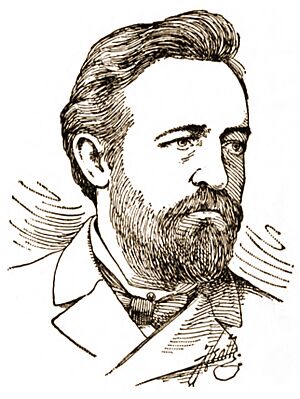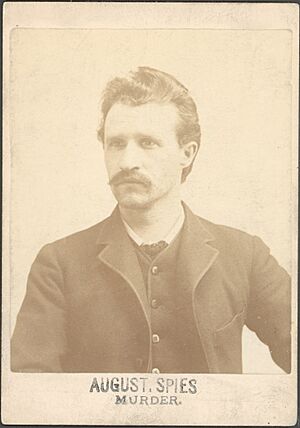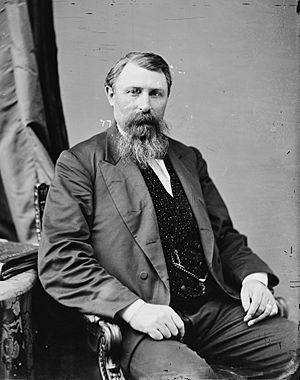Paul Grottkau facts for kids
Paul Grottkau (1846–1898) was a German-American activist and newspaper publisher. He is best known for editing the Chicagoer Arbeiter-Zeitung (Chicago Workers' News). This was a very important newspaper for workers in the 1880s. Later, Grottkau moved to Milwaukee, Wisconsin, where he became a key leader in the movement for workers' rights.
Contents
Paul Grottkau's Life Story
Early Life and Education
Paul Grottkau was born in 1846 in Berlin, Prussia (which is now part of Germany). He came from a well-off family.
He trained to be an architect. As part of his training, he learned how to be a stonemason and builder. This work brought him into contact with regular workers. It was here that he first learned about ideas of socialism, which is a way of thinking about how society should be fair for everyone.
Grottkau was inspired by the ideas of Ferdinand Lassalle, who believed in making changes through elections. By 1871, Grottkau was already a member of a big workers' group called the General German Workingmen's Association. He helped organize for the growing social democratic movement, which aimed to improve workers' lives. He also edited a newspaper for bricklayers called Grundstein and another radical paper called Berliner Freie Presse.
His political activities caught the attention of the German police. To avoid being arrested under the Anti-Socialist Laws (laws against socialist groups), Grottkau moved to the United States in 1878. He was a talented writer and speaker. He found his way to the German community in Chicago and quickly got a job at the Chicagoer Arbeiter-Zeitung, a newspaper that supported workers' rights.
Working in Chicago
Soon, Grottkau became an editor of the daily Arbeiter-Zeitung. He worked closely with August Spies, who was the managing editor. Spies was later killed after the Haymarket affair in May 1886, a sad event where a bomb exploded during a workers' protest. Grottkau, Spies, and Albert Parsons became important leaders of the workers' movement in Chicago during the late 1870s and early 1880s.
During this time, the workers' movement in Chicago started to consider more radical ideas, like anarchism. Anarchism is a belief that society should have no government. The number of members in the main socialist party dropped, while smaller anarchist groups grew. Grottkau, like many others, was briefly interested in these ideas. The Arbeiter-Zeitung even became a leading voice for anarchism in America for a while.
Historians believe Grottkau joined these "Social Revolutionaries" (anarchists) because he wanted to change the leadership of the Socialist Labor Party. He felt the party was too slow to act. Even though he disagreed with some of their methods, he joined an anarchist group called the Lehr und Wehr Verein for a short time.
However, Grottkau eventually disagreed with Spies and Parsons. This happened after a meeting in Pittsburgh in 1883, where the Revolutionary Socialist Party decided to support anarchist communism. After this, the Social Revolutionaries became full anarchists, while more moderate people like Grottkau returned to the Socialist Labor Party.
This disagreement became very clear on May 24, 1884. Grottkau debated Johann Most, a leading anarchist, in Chicago. Morris Hillquit, an early historian of American socialism, said it was a great debate. Both speakers were very good and knew a lot about the topic. The debate was written down and shared widely.
Another historian, Frederic Heath, said this debate was a turning point for Grottkau. He realized that anarchists were not helping the workers' movement. He spoke and wrote strongly against them. Even though he won the debate, the crowd still remembered his earlier anarchist ideas. A few weeks later, he had to leave the Arbeiter-Zeitung. August Spies, who was more aligned with Most's ideas, took over as editor.
Moving to Milwaukee
After leaving his job in Chicago, Grottkau moved to Milwaukee, Wisconsin. There, he started his own newspaper called the Milwaukee'r Arbeiter-Zeitung (Milwaukee Workers' News). It was published three times a week, starting in 1886.
Grottkau became a leader of the Milwaukee Central Labor Union. This group, along with the Knights of Labor, organized a big march in Milwaukee on May Day (May 1st) in 1886. They were protesting for an 8-hour day, meaning workers would only have to work eight hours a day. About 16,000 people joined the May Day events, with thousands marching to support the workers' unions. This march happened peacefully.
However, on Monday, May 3, 1886, a general strike began at Milwaukee's breweries. About 1,000 men marched to Falk's Brewery to try and close it down. Many brewery workers joined the protest, and by that evening, about 14,000 brewery workers were on strike. That same afternoon, some Polish workers went to the railroad shops to ask the 1,400 railway workers there to join the strike. Most refused, and police were called to break up the group.
The Polish strike leaders then went to the Reliance Iron Works. There, fire hoses were turned on them, and the strong water streams knocked some men across the street. About 20 police officers arrived and started hitting the wet strikers with their clubs. Governor Jeremiah McLain Rusk was told about the situation. Several units of the United States National Guard (soldiers) were sent from Madison, Wisconsin, and arrived the next morning.
Around 7 AM, about 600 or 700 men, carrying clubs, gathered and began to march towards the steel mills in the Bay View area of the city.
The protest became violent. One person who supported law and order at the time described it: "Workers marched in the streets; people willing to work were forced to join. Crowds with paving blocks and other weapons overturned stands, entered factories, and even attacked them." As the situation worsened, soldiers fired their rifles into a crowd of Polish workers. This stopped the violence that seemed to be getting out of control.
The same historian noted that "not one person was wounded in the volley." He said, "Many of the crowd, seeing the rifles aimed, dropped to the ground, others hid behind woodpiles and fences. It seemed like a miracle that no one was killed or hurt."
On the afternoon of Wednesday, May 5, 1886, strikers gathered again to march on the company town of Bay View. This time, Governor Rusk had given new orders to the National Guard: if the crowd became violent again, the soldiers should shoot to kill. The soldiers blocked the road. When the strikers were about 1,000 yards away, the commanding officer, Major George P. Traeumer, ordered them to fire. A hail of bullets was shot into the crowd. We don't know how many people were hurt, as they were carried away by the fleeing crowd. However, eight people died in what is now known as the Bay View Massacre. Among those who died were an old man feeding chickens in his yard and a young schoolboy.
After these events, Paul Grottkau was arrested. He was accused of causing the strike and sentenced to one year in prison. However, Grottkau only served six weeks before being released. While in prison, he even ran a campaign to become the next Mayor of Milwaukee.
Grottkau continued to edit the Milwaukee'r Arbeiter-Zeitung until 1888. He then briefly moved back to Chicago to work on the original Arbeiter-Zeitung newspaper there.
Later Years and Passing
In 1889, Grottkau moved to San Francisco, California. There, he became the editor of a short-lived newspaper called the California Arbeiterzeitung.
In 1890, Grottkau was chosen by the American Federation of Labor to be a traveling organizer. His job was to travel around the country to promote the Federation's campaign for the 8-hour workday.
In January 1893, Grottkau's old newspaper, the Arbeiter-Zeitung, was sold to a young teacher named Victor L. Berger. Berger renamed the paper Wisconsin Vorwärts (Wisconsin Forward). This was the first of many newspapers Berger would own. He later became the first socialist elected to the United States Congress in 1910.
In his last year, Grottkau joined the Social Democracy of America, an early group that led to the formation of the Socialist Party of America.
In the spring of 1898, Grottkau went on a speaking tour for the Social Democracy. He visited cities like Buffalo, Cleveland, and Detroit. During this trip, he caught pneumonia, a serious lung infection. He was hospitalized in Milwaukee on May 30. His health got worse, and he passed away on the evening of June 3, 1898.
A funeral was held in Milwaukee on June 5, 1898. Victor L. Berger spoke at the service, along with other important labor and political leaders from Milwaukee. Paul Grottkau was buried at Forest Home Cemetery in Milwaukee.
Images for kids








